With each new discovery, the mystery of this predator’s appearance and behavior only deepens, and PNSO’s latest iteration is a figure so distinct from its predecessors that it’s almost as unrecognizable as the real creature.
Indeed, I’m almost starting to wonder if Spinosaurus is an elaborate prank being played out on us by the powers that be. First described by Ernst Stromer in 1915, Spinosaurus aegyptiacus made a belated rise to stardom in 2001 as the big bad of Jurassic Park III. Since then, scientific understanding of the creature has been increasing and changing on what seems like an exponential level, and boy howdy, has Spinosaurus turned out to be a WEIRD animal. With each new discovery, the mystery of this predator’s appearance and behavior only deepens, befuddling paleontologists and challenging paleoartists. I daresay Stromer would have difficulty recognizing the beast he named were he to see its depiction today.
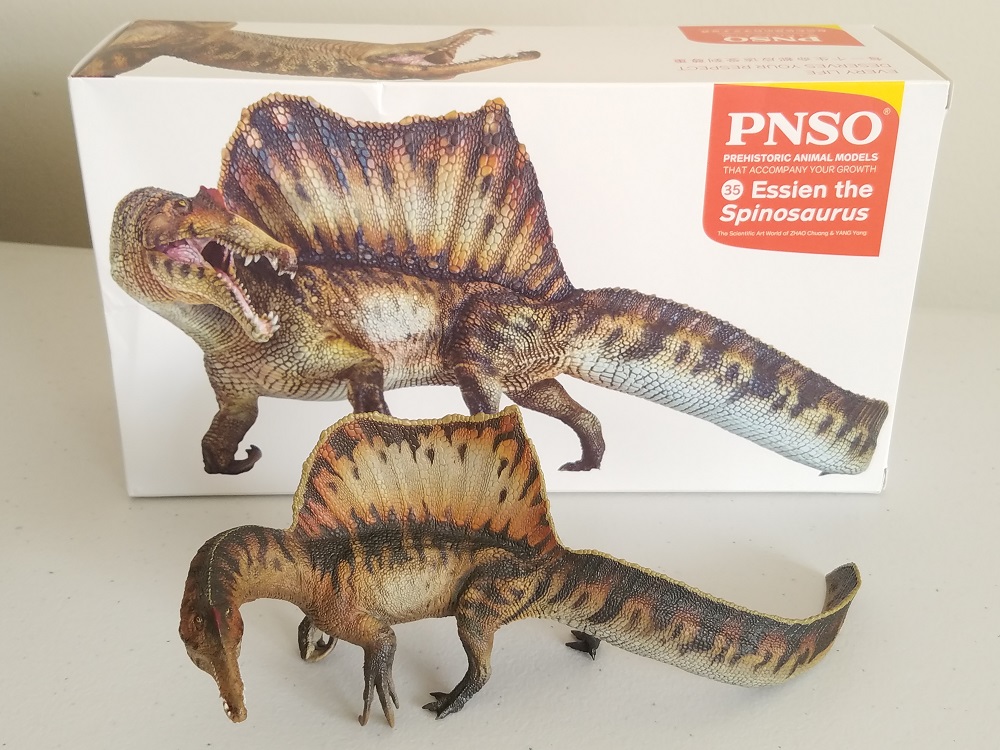
The conundrum of science is the boon of consumerism, however; toy and model companies have been happy to pump out as many new Spinosaurus models as they can. Regardless of other problems being faced in the year of 2020 and onwards, collectors and fans are certainly spoiled for choice among brands and figures available now. The Peking Natural Science Organization (PNSO), which had previously released a large museum model of the genus under the nickname “Essien” (and a couple of minifigures under a different nickname), decided to hop on the bandwagon once again in 2020 for their new line of cheaper, mid-sized models. The result is a figure so distinct from its predecessors that it’s almost as unrecognizable as the real creature.
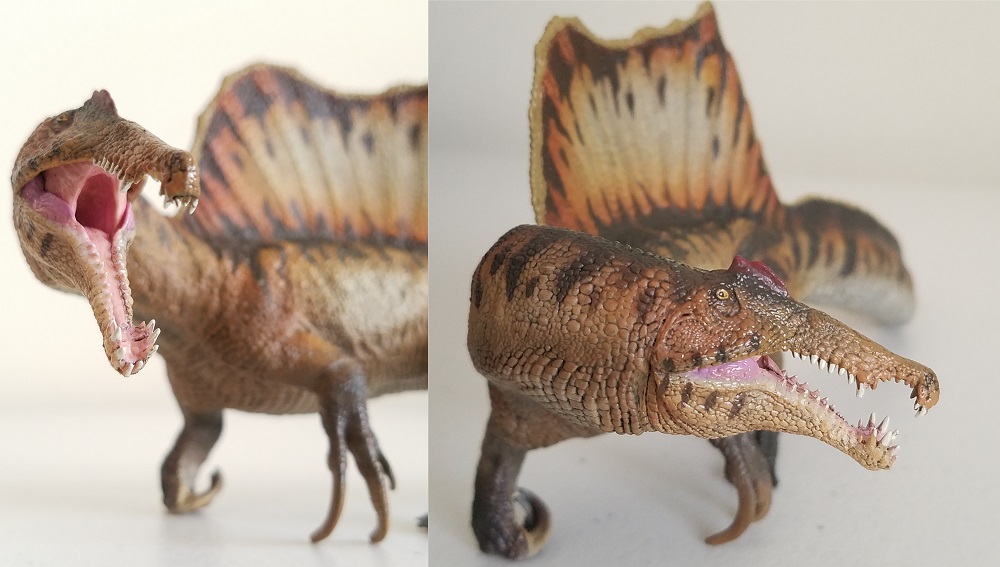
Marked as no. 35 in the Prehistoric Animal Models line, PNSO’s Essien the Spinosaurus 2.0 (2020.0? Heh, sorry) comes in a spacious box with bilingual writing. A foldout booklet describing the company and Essien as a character is included inside. The PVC material of which the model is made is very firm, but also flexible: the claws, fin, and sail are slightly bendable. Like most of PNSO’s theropods, Essien has a hinged jaw for varied display – and I must say, the articulation is smoothly disguised and functions perfectly. Essien’s mouth looks equally great whether agape or shut tight. Although Essien is officially listed as about 23cm (9in) long, when measuring along the spine the figure is closer to 30cm (11.75in). These measurements place Essien within the 1:50 scale for a 15m live individual, or 1:36-40 scale for an 11-12m individual. Some collectors have expressed disappointment over the model’s more modest size. It’s by no means a tiny figure, but it does perhaps look larger than it really is from the official publicity shots.
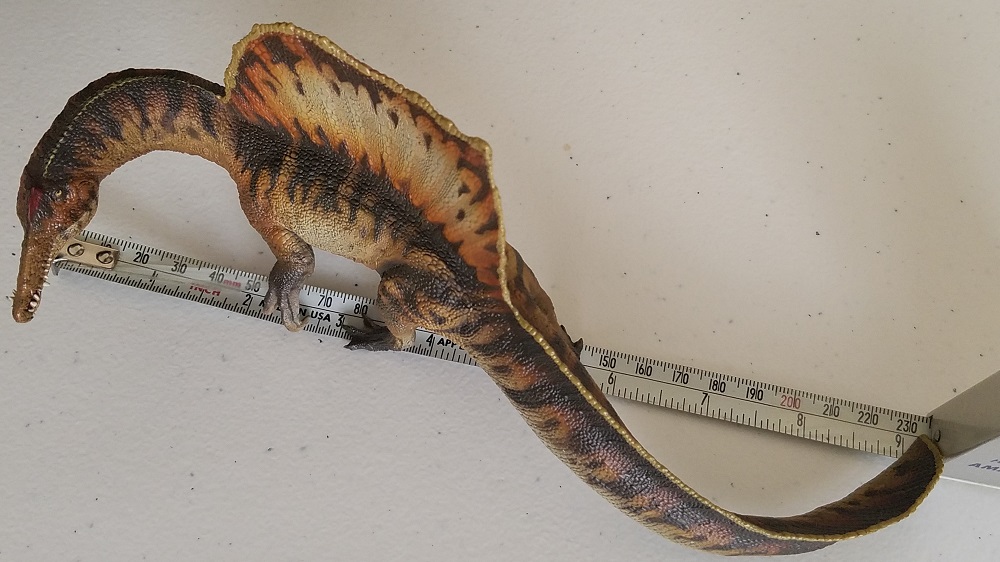
The fact that the figure looks so much larger in promotional photography than it really is in person might be a testament to how exquisitely detailed the figure is. Every millimeter of Essien’s body is adorned in fine, scaly skin which matches the folds and stretches of the body’s shape and is patterned in a variety of scale shapes and sizes. Although the scale of the, um, scales, is likely exaggerated for the sake of the figure – the rare dinosaur skin impressions we have usually indicate much finer scales that wouldn’t be visible on a model – the detail is so excellently applied that the result feels incredibly lifelike regardless. Alternating patterns distinguish the vertebral spines in the sail and fin, accentuated by a slight glossy sheen. Some larger rows of scales or osteoderms are present along the back, but the appearance avoids looking obviously crocodilian – a tendency in reconstructions that honestly gets tedious and may not hold up well in the long run. The most crocodilian feature is actually probably the rectangular scales lining the underbelly of the figure, which warp and stretch with precise coordination to the pose of the figure.
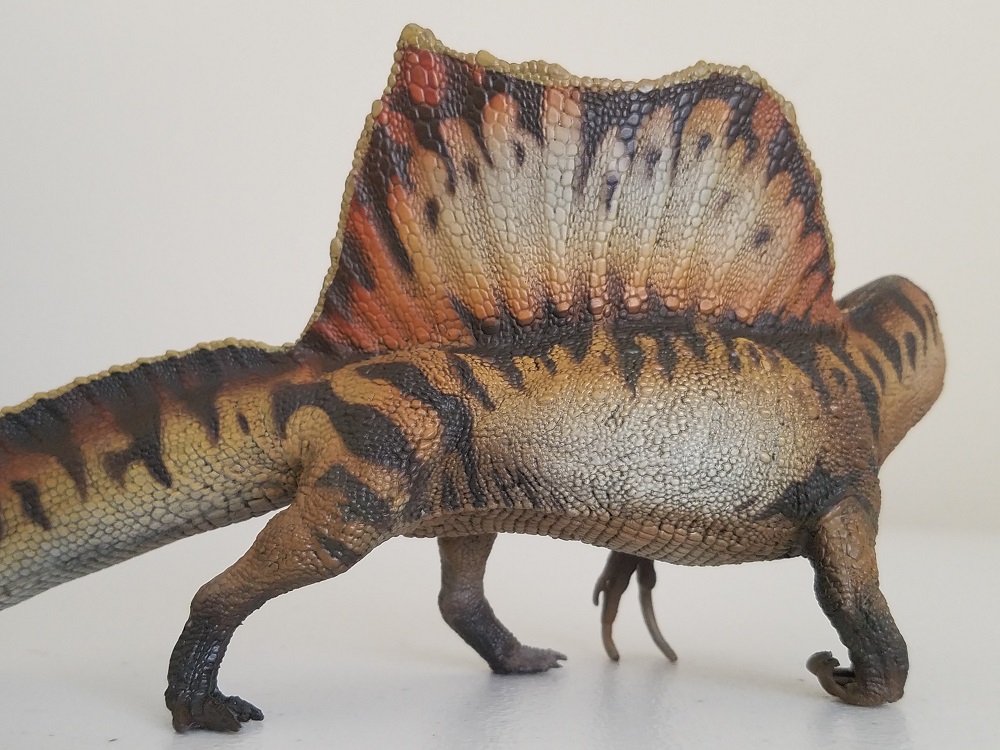
Apart from some faint fenestrae outlines at the back of the skull, this figure is stocky and muscular all over. The neck and tail look thick and strong – generously so for the tail, which was reconstructed more conservatively in the 2020 Ibrahim et al. paper (it has since been suggested to be much thicker than the paper described). The upper body is broad, and the limbs are flexed and toned as they support the animal’s weight. More details to the muscles beneath the scales are evident around the body, with subtle folds and stretch marks in the throat and hindlimbs, slight bulging of what may be tendons or veins (almost more noticeable to the touch than to the eye), all the way down to a small cloacal opening at the base of the tail. There are a couple of spots along the underside of the tail which looked damaged or smoothed out, so detailing isn’t entirely perfect.
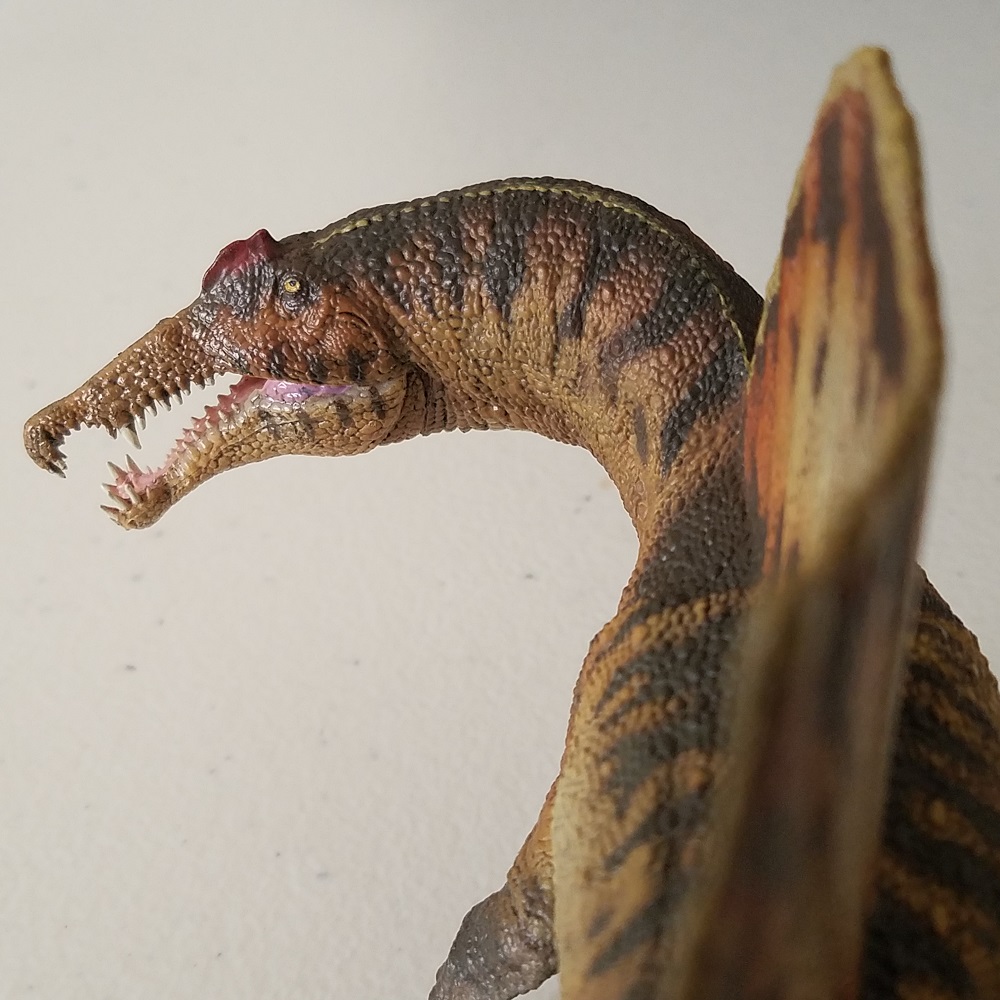
All of Essien’s sculpted soft tissue detail comes layered atop a skeletal frame which appears rigorously accurate to the Ibrahim et al. reconstructions, with a few curious exceptions. The skull, in profile, is nearly perfect in shape; only some additional rounding of the edges on the posterior end deviate from fossil material, and this might be chalked up to soft tissue filling in the spaces. From a frontal view, however, the posterior half of the skull appears remarkably broad in contrast to the snout, resulting in a very gharial-like appearance. I’m not used to seeing Spinosaurus’s skull reconstructed in this manner, so I think PNSO may have taken some artistic license here. The teeth are each individually sculpted and quite pointy, down to the tiny teeth in the notch; I think the number of teeth has been closely accounted for based on known skull material.
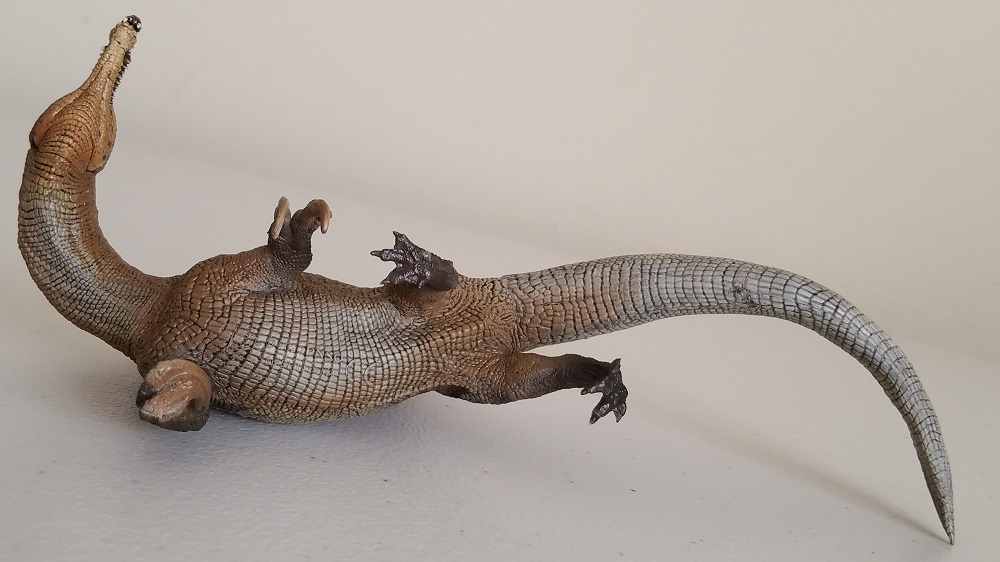
Essien’s feet appropriately depict the oddly flat, four toed shape known from the 2014 findings, and include modest webbing between each of the digits. Surprisingly – to me, at least – Essien’s feet might be even smaller in proportion than what is depicted in skeletals. The iconic dorsal sail is also rendered precisely in shape to the 2014 reconstruction. The M-shape, although currently popular, has been receiving criticism and skepticism, but without more fossil evidence it’s likely to stick around for now. I won’t fault PNSO for their close adherence to this design. Of course, the recently described tail fin is represented, too, with the tail comfortably but not too extremely curved to one side. Essien appears overall flexible in life. As mentioned before, the tail is given substantial musculature down its entire length, which layers over the underside and overlaps the base of the upper spines. The dorsal sail, meanwhile, is granted no additional tissue.
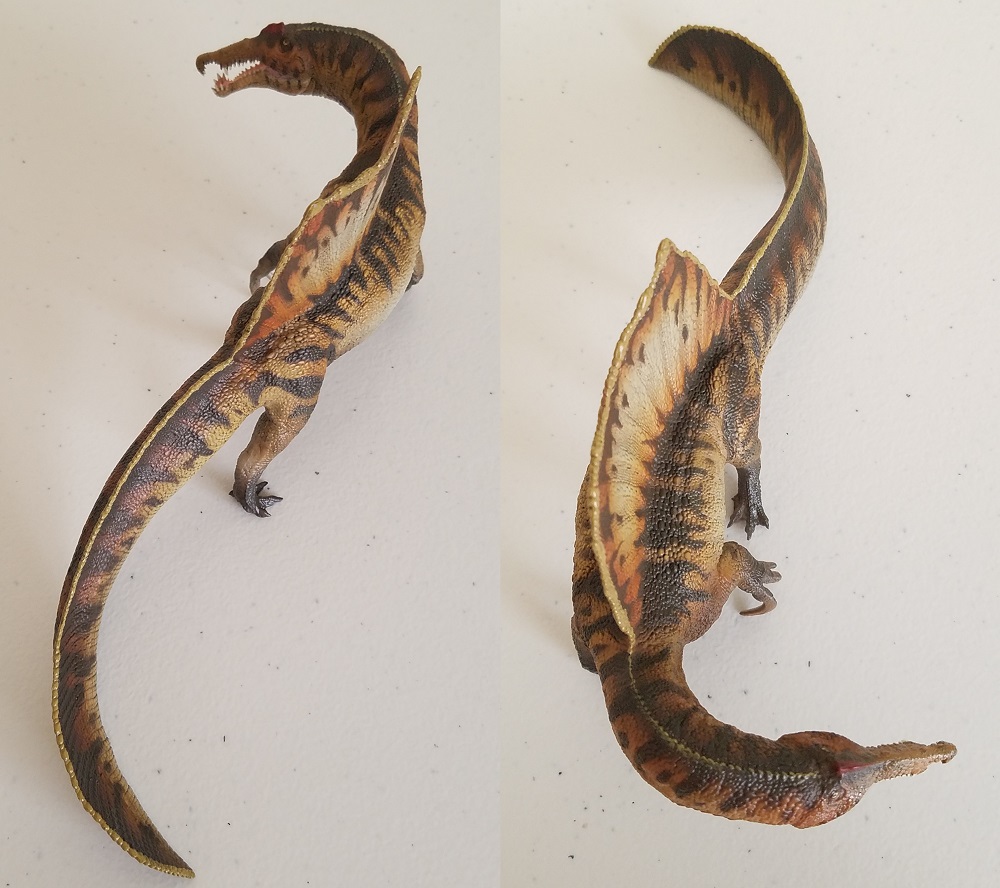
Essien is posed on all fours, with the right forearm bearing the frontal weight of the figure. The default posture of Spinosaurus remains hotly debated, ever since the 2014 findings suggested a quadrupedal stance. PNSO has opted to follow the Ibrahim et al. findings again, with Essien resting upon its knuckles in a fashion highly reminiscent of giant anteaters today. While arguments against this gait will mention (among other points) the lack of evidence for Spinosaurus‘ arms to be capable of bearing the animal’s weight – and the lack of such adaptations being known from any other spinosaurids so far – the truth of the matter is that we have next to nothing in the fossil record for its arms. Considering how unpredictable the rest of the animal has been so far, it wouldn’t surprise me at all if we did, in fact, find Spinosaurus arm fossils in the future which showed evidence of quadrupedalism. Only time can tell, of course, but for now at least, Essien makes this locomotion method look quite reasonable. The primary and secondary digits are endowed with generously long claws – artistic license again, but reasonable considering how extensive keratin sheathes can be on some living animals.
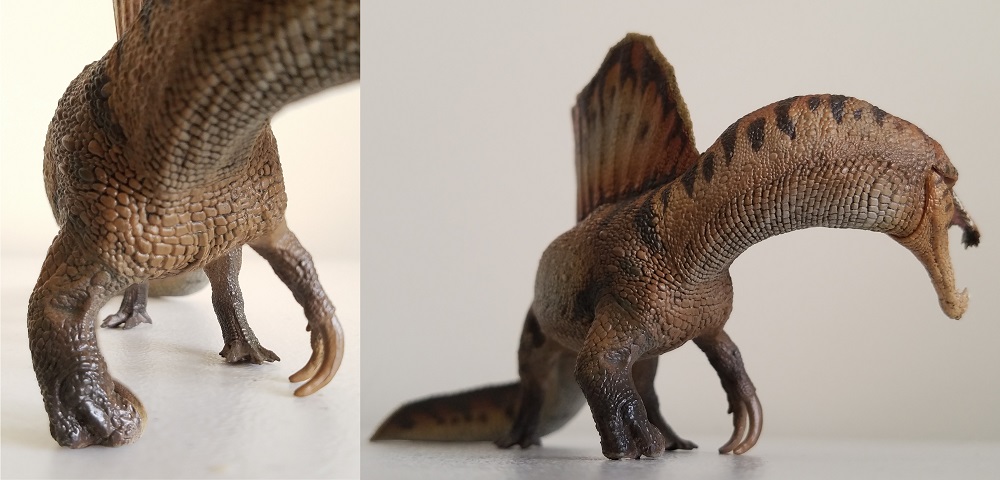
When PNSO’s first “Essien” from the Museum line was released, feelings were mixed about differences in the paint job between the prototype, the promotional art, and the final model. The 2020 model, thankfully, matches its promotional imagery just fine, with a multi-graded pattern of earthy browns, yellows, and oranges, topped with jagged black stripes along the back and sail, all the way down the tail fin. The overall effect is a color scheme which looks perfectly fitting for a large freshwater predator, reminiscent of some modern-day reptiles and fish (I’m particularly reminded of the saddled bichir, an African fish popular in the pet trade). Sometimes, dinosaur toys have trouble striking a balance between eye-catching colors and natural hues, but PNSO seems to be doing just fine. The same attention to detail seen in sculpting is also applied to paint application, with only some small hiccups around the admittedly tiny eyes and teeth. Not all teeth are properly white, and my own figure has a bit of a lazy eye, but these are not details likely to be noticed without close attention. One other detail I took notice of is a sign of wear on the bottoms of the feet and the right arm’s knuckles. I’m not sure if this was a deliberate choice, or a sign of the pain rubbing off already. Hopefully, it’s the latter, but it’s something worth being aware of.
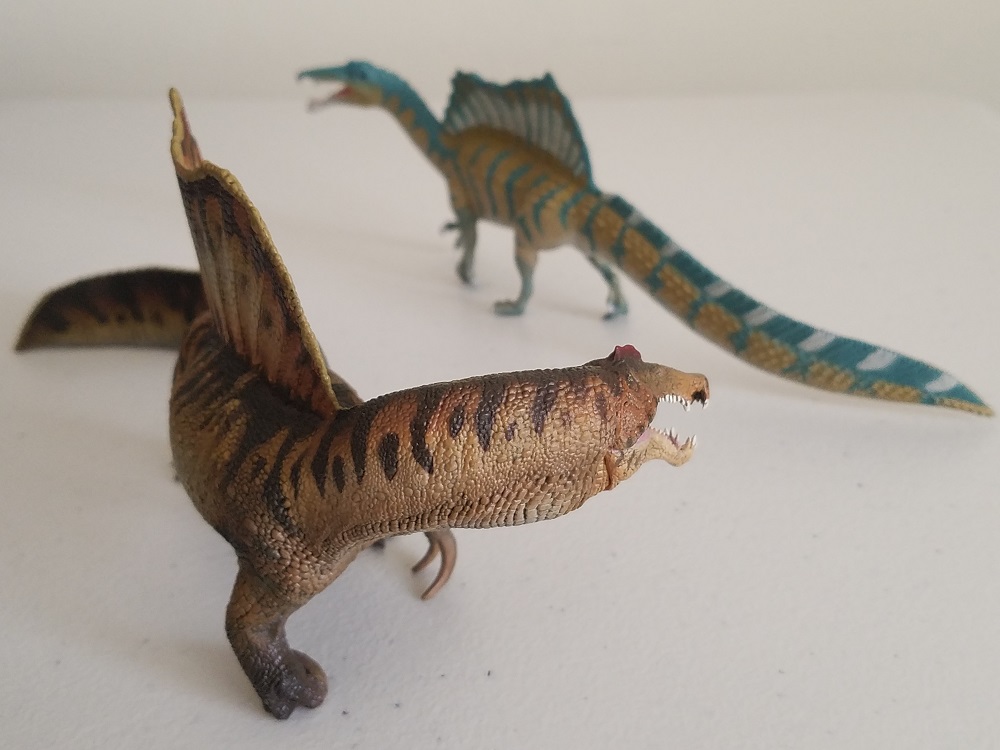
Science stops for no dinosaur, and the journey of discovery for Spinosaurus has been quite a roller coaster ride so far. Already another paper was published earlier this year regarding its behavior, and Safari Ltd. has released a new model of their own which seems to have timed well with the publication. There’s no telling what will change next for this enigmatic giant predator, and there’s sure to be many more toys to come. At this point in time, however, amidst all the Spinosaurus toys on the market, Essien here just might be one of the very best. I am thoroughly satisfied with this purchase and I highly recommend it to any and all theropod enthusiasts. If you’ve finished reading this review eager to grab an Essien of your own, you’ll be glad to know there are multiple online stores carrying the PNSO line, including Everything Dinosaur and AliExpress, which are the sites I would recommend checking first. PNSO also has their own page on Amazon where you can find Essien along with many of their other prehistoric life models.
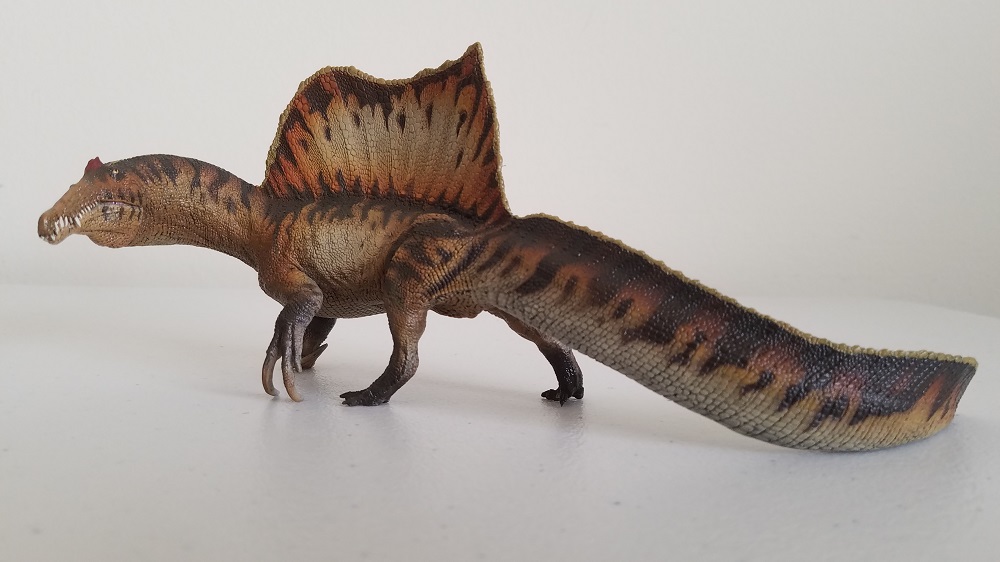
Disclaimer: links to Ebay and Amazon on the DinoToyBlog are affiliate links, so we make a small commission if you use them. Thanks for supporting us!





Idk at this point I’m inclined to say facultative quadroped; with it’s proportions I can’t imagine it NEVER walked on all fours, but I can imagine it also being bipedal as needed.
That being said, this is definitely my favorite spino.
The evidence seems to be leaning towards bipedalism, but only time will tell in the end. Either way, this is still one of the nicest renditions of the animal to date!
I wish it was cheaper 🙁
Excellent review! I agree that this is the best of the latest crop of Spinosaurus. I’m not a fan of, or convinced by, the knuckle walking though. I don’t know that I’ll get it but if I were to get a new Spinosaurus this would be the one.
Nothing walks on its knuckles.
I suppose that’s true. What part of their hands do anteaters use? That seems to be the method PNSO is imitating for the model.
Anteaters absolutely walk on their knuckles, as do some apes. https://pubmed.ncbi.nlm.nih.gov/15861420/ (paywalled, but you can message me for a pdf.) Maybe you mean this in the very strict sense that anteaters are actually walking on the distal phalanges, but they’re certainly using the dorsal rather than plantar surface of the manus. I’ve heard that platypuses do, too, but I don’t know anything about the mechanics of it.
OK, found a source on platypuses: https://jeb.biologists.org/content/204/4/797.short
A complete review and honestly, as the article says, what is deceiving is the size, I would have celebrated a version of PNSO spinosaurus with a larger size, but without a doubt, as this detailed article comments, it is a millimeter well-made figure to the last Detail and most importantly, it is quite economical for the outstanding quality of this figure like that of all the PNSO of these last two years to give a few examples. Super recommended for all collectors and lovers of popular dinosaurs such as spinosaurus.
Great review of this impressive model, easily the best one out there at least for me.
The sculpting and details are just amazing!
Nice review.
I must admit i’m having trouble keeping up with Spino’s changes. He’s now considered a quadruped, again? Both the PNSO and Safari models imply that anyway or is that just for figure stability?
The good news I guess is that they are running out of things to change on Spino. The legs, head and tail are all decently known, now. I guess just the exact shape of the sail is the only major question mark left. Lots of smaller unanswered questions but that seems to be de rigueur for our beloved dinosaurs.
I did read something recently about new research indicating it was a wader, like a stork and did not normally swim after its prey and that the tail is less efficient for swimming than a modern crocodiles.
I don’t know if I can make sense of the wading idea. Its legs are pretty short, not really built like a wader. It would only be able to wade out into relatively shallow water, where the fish would be pretty tiny for such a big predator.
In the case of the Safari figure, it’s just stability; but the PNSO is clearly taking the quadruped stance.
I don’t think there’s been a settled answer since 2014 about Spinosaurus’s locomotion; it depends on whom you ask. The Ibrahim team seems to be in support of quad, while Hone’s and Holtz’s new paper supports biped.
To me it just not feels to be a “walking” Pose. This Figure uses its Knuckle for balanceing in this case. At least it looks like this to me. As you wrote earlier and in your great Review, we do not know.
It just feels the Discussion about being on its forlimbs or not is often just black and white. “He wasn’t quadroped = he was not allowed to touch the ground, or he will shatter in 1000 pieces!” 😀 Or the other way.
Its just a fantastic Figure in the End, i love it and you did a great Review on it 🙂
This has been the blog’s 50th Spinosaurus review.
Sweet; I hope it’s a worthy one!